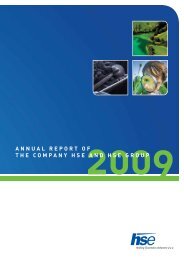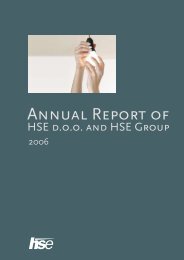Annual report - HSE
Annual report - HSE
Annual report - HSE
You also want an ePaper? Increase the reach of your titles
YUMPU automatically turns print PDFs into web optimized ePapers that Google loves.
In 2012, the company’s risks were managed with the following activities and methods:<br />
• Weekly review of the fundamental analysis of changes in electricity prices;<br />
• Weekly examination of events taking place in non-transparent markets that could lead to<br />
changes in market conditions in the electricity market;<br />
• Daily analysis of <strong>HSE</strong>’s position;<br />
• Monthly reviews of price curves in relation to transactions concluded in various countries<br />
and the value of cross-border transmission capacities;<br />
• Gathering of quality and up-to-date information from local sources.<br />
Price risk<br />
Price risk is the risk arising from fluctuations in market prices of electricity and market prices<br />
of other energy products (coal, gas, emission coupons, oil etc.) that have a direct impact on<br />
electricity prices or <strong>HSE</strong>’s operations. On the one hand, price risks affect the sales revenue<br />
(e.g. lower market prices of electricity lead to lower market values of electricity not yet sold<br />
by <strong>HSE</strong> subsidiaries), and on the other, expenses associated with the company’s operations<br />
(e.g. higher prices of CO 2<br />
emission coupons increase production costs of subsidiaries<br />
emitting CO 2<br />
).<br />
In 2012, the company <strong>HSE</strong> managed its price risks with the following activities and methods:<br />
• Daily monitoring of the market position on group-level and on the level of <strong>HSE</strong> by<br />
countries and individual groups of transactions that have a similar purpose and/or<br />
significance. In the event that in a certain moment the position exceeds the quantities<br />
allowed by the rules, it is corrected accordingly (conclusion of a purchase or sale<br />
transaction). For optimisation of the market position, we use both contracts for supply,<br />
i.e. sale, of physical energy and derivatives involving physical settlement (forwards). In<br />
2011, the market position never exceeded the limit defined by the rules;<br />
• Daily monitoring and limitation of trade in illiquid markets, as well as liquid markets<br />
where supply is expected further away in the future, in connection with market volatility;<br />
• Daily hedging – conclusion of counter-transactions involving the same quantity in the<br />
same market, or purchase of derivatives involving financial settlement (futures), if they<br />
exist for the market in question, depending on the type of the trading transaction;<br />
• Daily monitoring and analyses of prices of energy products and projections regarding the<br />
expected changes in prices of energy products in various markets;<br />
• Daily monitoring of market activities in the CO 2<br />
emission coupons market, investment<br />
decisions in the EU energy sector, and monitoring of economic growth of leading<br />
countries;<br />
• Daily monitoring and analyses of the value of VaR and MtM (Mark-to-Market) parameters<br />
by individual groups of transactions of the company <strong>HSE</strong> with a similar purpose or<br />
significance, taking into account the limitations or values of VaR determined by the rules;<br />
• Daily monitoring of the value of the coverage used for price fluctuations for transactions<br />
intended to generate added value or minimise the risk of losses in accordance with the<br />
principle of good management;<br />
• Weekly examination of conditions, prices and developments in the electricity markets;<br />
• Bi-weekly examination of the company’s exposure to risks by individual groups of<br />
transactions with similar purpose and examination of conditions in oil and coal markets.<br />
More information on price risk management is disclosed in Notes 4.5.8.8.5 and 5.5.8.8.5 of<br />
the financial part of this <strong>Annual</strong> <strong>report</strong>.<br />
Quantity risk associated with deviations from contractual<br />
quantities<br />
Quantity risk associated with deviations from contractual quantities is represented by<br />
the difference between the actually supplied or received quantities and the projected<br />
quantities. The difference must be additionally purchased or sold in the market, frequently<br />
under less favourable conditions; similarly, production shortfalls must be covered with<br />
electricity purchases, the market price of which is usually higher than the contractual price.<br />
<strong>Annual</strong> Report <strong>HSE</strong> 2012<br />
2 Business Report<br />
85
















